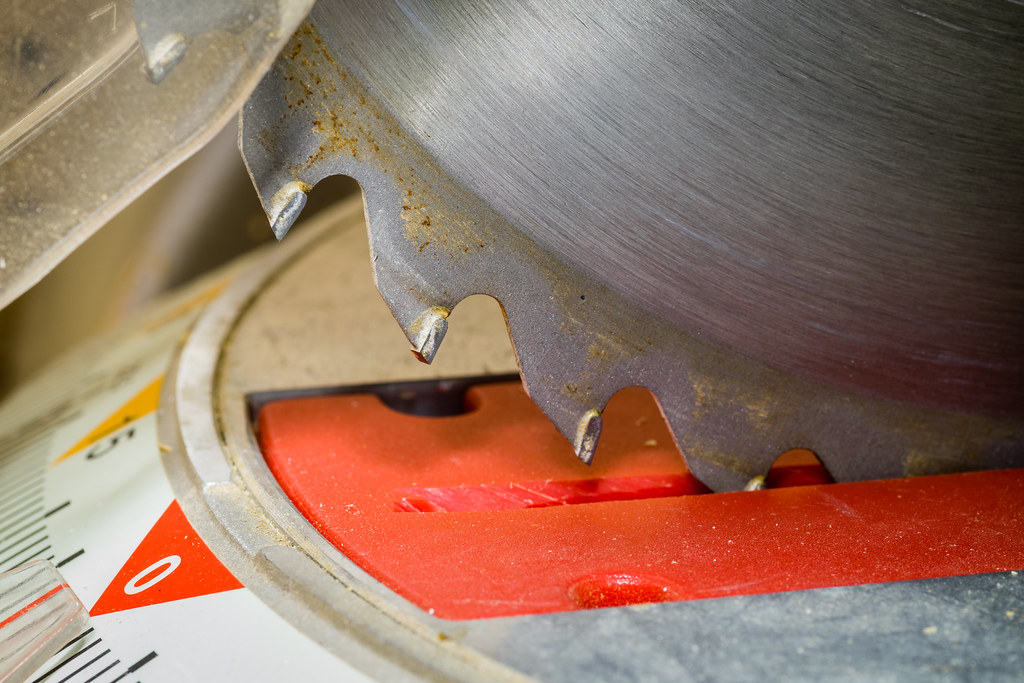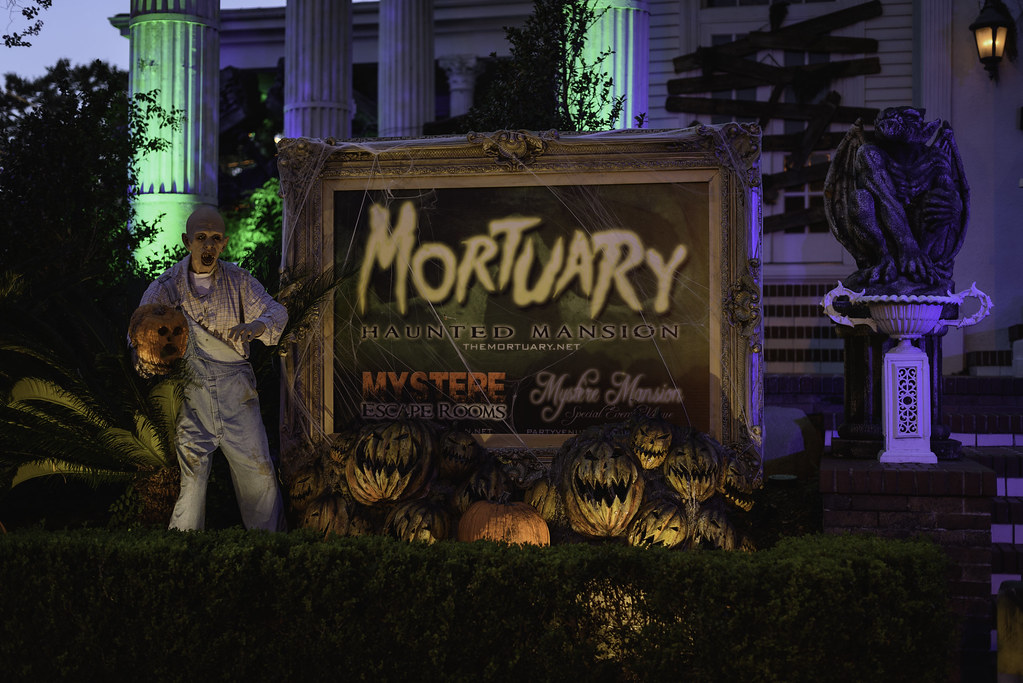
Photo of: Round saw blade
(Photo by: Marcy Leigh)
Saw, the first of a series of horror movies came out in 2004. The story of the film is that there are two men who are trapped in a bathroom along with a dead body. Killer Jigsaw forces these prisoners to complete puzzles in order to survive, but one must also kill the other to avoid his family being killed. The hacksaw is introduced as a method of torture, a way that the victims were to have their feet cut off as part of these games. The Texas Chainsaw Massacre was originally released in 1974 as a graphic and bloody horror movie that follows a group of friends who encounter cannibals. These cannibals murder their victims with chainsaws. Since the Hays Code, a collection of strict laws governing what can be portrayed on screen, was replaced, chainsaws have been depicted as a weapon in movies and television at increasing rates. As humans, we engage in activities that evoke deep feelings of fear, despite our widespread fears about death. A 2015 poll from the Chicago Tribune showed that each Halloween, 55% of people watch a horror film- and the majority of these people enjoy it. Yet, a Statista poll displays the contrasting evidence that 50% of people fear death.
During the Paleolithic Era, objects from the natural world were used as saws. Shark teeth served as inspiration, which then led the earliest humans to use gum to glue blades of grass onto rocks. In Chinese culture, there is a legend that says Lu Ban created the saw. He was cut by a leaf with ragged edges and inspired to create his own version. Greek mythology says that Talos noticed the bones of a fish and wanted to recreate a useful interpretation of this. By 4900 B.C., the Egyptians learned how to make larger teeth that helped with construction on a larger scale. The Romans learned to shape the teeth of the saw while also utilizing an iron frame providing more support, and by 1775 the handsaw resembled what exists today. These saws consisted of a handle and a sharp jagged blade with the potential to cut almost anything, and this remains the core idea of a saw even today. Aichmophobia. The fear of sharp objects. This phobia has a likely culprit of our evolutionary background. In the simplest of terms: sharp equals harmful. This was necessary for survival a long time ago, and our brain continues to fire signals of distress at the sight of perceived danger.
Varieties of saws include the classic circular saw, used for cutting wood and other materials, such as metal in construction. There is the Japanese saw, with its tall and narrow teeth that allow for precise cuts. The jigsaw, not to be confused with the horror movie character, is useful in cutting shapes out of wood as well as adding curves. During the holiday season many families will obtain trees cut down with bow saws. Then we have the chainsaw, used in collecting wood. The chainsaw is also used in haunted houses to terrify unsuspecting guests. Saws have the power to construct or deconstruct. Orthopedic saws are used to amputate limbs and separate the bone, while other surgical saws assist in operations like knee surgeries. The bone saw is used in cadaver dissection along with the sternal saw which breaks through the chest of the body. This popular tool is a staple of terror, is this because of the sheer power it possesses to deconstruct everything, even things that we believe to be permanent? Or is it simply because as humans, we react to not only violence and gore, but the possibility of violence and gore. It is in this combination that the chainsaw grew in popularity as a symbol of horror.
Some of the most brutal of murders result in the body being dismembered. Serial killer Jeffrey Dahmer used saws on his victims while they were living and even after they were dead. When something scares us, a part of our brain known as the amygdala immediately triggers the release of stress hormones which allow us to enter the fight or flight response. Our bodies experience heightened senses, less pain, and increased strength when these neurotransmitters are acting on us. When we know that we are not actually going to die, these neurotransmitters and hormones that provide us with an adrenaline rush make us feel good.
According to Dr. Bonn, a criminology professor, humans are fascinated by serial killers because the possibility of being murdered by one is about the same possibility of us being attacked by a great white shark. This is the same possibility of any one of us actually finding our way into a horror movie. There is not a real risk, but we try to humanize the serial killer, real or fake, to lessen the fear anyway. The hypothalamus activates the sympathetic nervous system, which sets off a chain of reactions that end with norepinephrine and epinephrine being released to the bloodstream. In other words, instead of worrying about the future or other day-to-day stressors, we are focused entirely on the present when we undergo this response to stress and fear. Beyond this, the serial killer represents all of us in our darkest thoughts and Dr. Bonn believes this is what drives the fascination. This fascination of death extends beyond serial killers and into the realm of humans actually putting themselves into situations that evoke pure terror.

Photo of: Mortuary Haunted House in New Orleans
(Photo by: Pherit)
The Mortuary Haunted House in New Orleans is one example of these activities that enlist the neurotransmitters that begin the fear response. This house operates as a series of escape rooms for the majority of the year. Keeping up with the idea of a haunted house, these escape rooms include names such as, “Serial Killer’s Lair” or “Zombie Escape”. In the serial killer escape room, guests feel like they are really in the Saw series as they engage with puzzles that lead to jump scares. In September each year, the house is transformed into a traditional haunted house with a theme that varies. The basement, although not actually underground, typically features a narrow winding hallway where visitors are chased by a man holding a chainsaw. Guests see this chainsaw and the amygdala signals danger. Cognitively, guests realize that there is not truly a sense of danger, so they are able to enjoy the adrenaline rush while also creating a shared experience with friends or family. Oxytocin give us feelings of warmth; it is the hormone of bonding. Other neurotransmitters like dopamine and serotonin are also released which furthers this feeling of happiness, relaxation and reward. It explains why humans have a tendency to want to scare themselves and seek out activities that create this adrenaline rush like sky diving, or bungee jumping. Dopamine, however, is also highly associated with drug addiction, gambling and smoking. Once guests finally emerge from such the dark and threatening environment of the Mortuary, there is a feeling of accomplishment. Guests are hooked and they want to experience this again and again, despite the fear it may bring. As humans, our reliance on scary things proves that we would rather trigger fear that is unnecessary, a way of escaping the monotonous routine and daily stressors of life.
.
 NOLAbeings
Multimedia artist Claire Bangser created NOLAbeings as a portrait-based story project that marries...
NOLAbeings
Multimedia artist Claire Bangser created NOLAbeings as a portrait-based story project that marries...
 Data corner: Adobe Suite (create a PDF, social media graphic, presentation, edit a photo and video
Data corner is where you go to work with analytics and top tech skills. It takes on everything from PERL and SQL to Canva and Sprout Social.
Data corner: Adobe Suite (create a PDF, social media graphic, presentation, edit a photo and video
Data corner is where you go to work with analytics and top tech skills. It takes on everything from PERL and SQL to Canva and Sprout Social.
